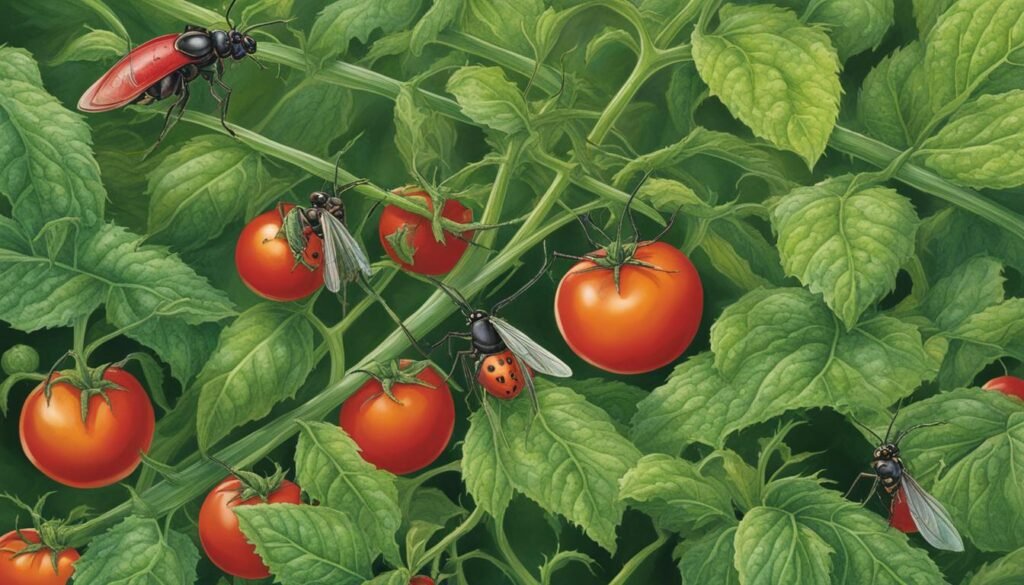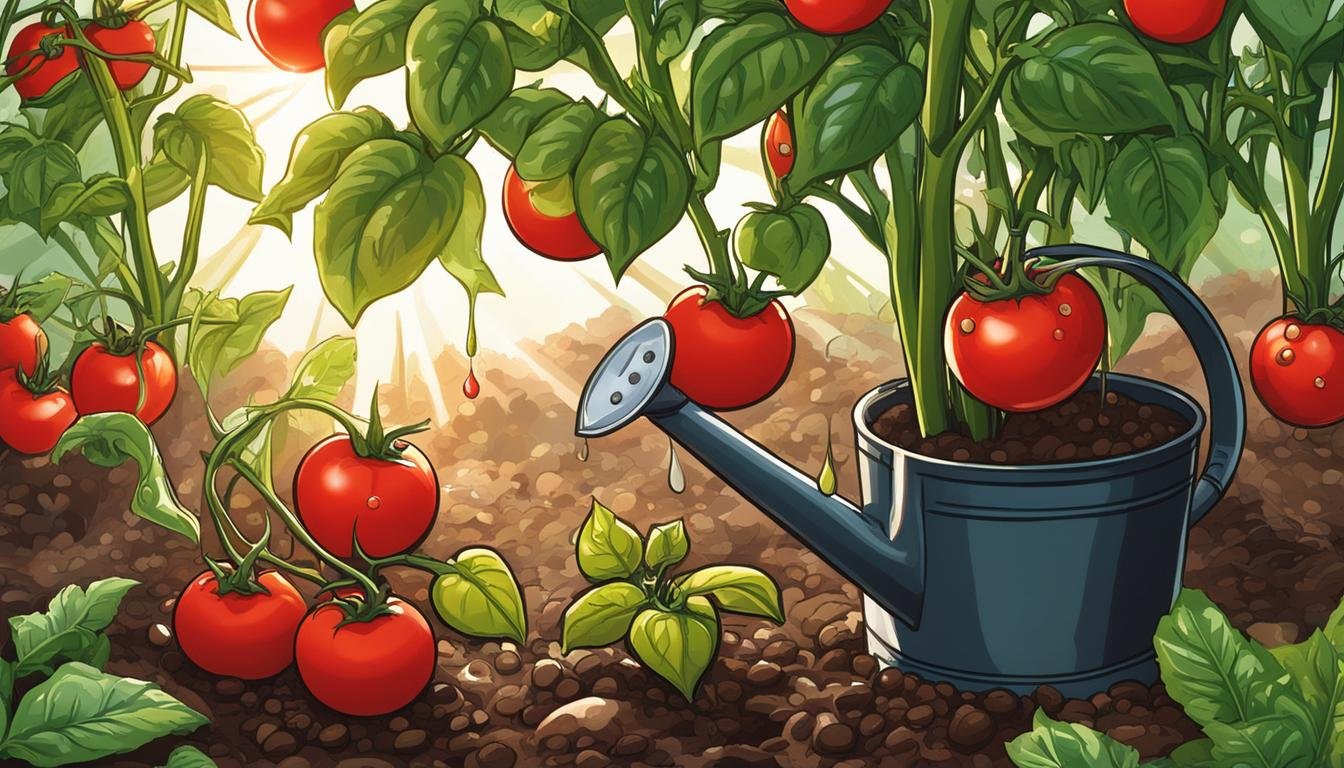Tomato plants are a beloved addition to many home gardens, but they can sometimes face challenges that cause them to wither and die. Understanding the reasons behind a dying tomato plant is crucial for implementing effective care and prevention strategies. In this section, we will explore common causes of tomato plant death and how to address them.
Key Takeaways:
- Lack of water, fungal wilt diseases, and tomato spotted wilt virus can cause a tomato plant to die.
- Proper watering, using resistant tomato varieties, and implementing crop rotation techniques can prevent these issues.
- Tomato plants require sufficient sunlight, regular watering, and well-drained soil for healthy growth.
- Yellow leaves, improper growth, and pests can also contribute to tomato plant death.
- Providing proper care, including adequate sunlight, watering, soil conditions, and nutrients, helps promote healthy tomato plants.
How to Prevent and Treat Wilt Diseases in Tomato Plants
Tomato plants are a popular choice for home gardeners, but they can be susceptible to wilt diseases that can cause wilting and stunted growth. To ensure the health of your tomato plants, it’s important to take preventative measures and treat any early signs of wilt diseases. Here are some tips to help you prevent and treat wilt diseases in your tomato plants:
Proper Watering Techniques
One of the main causes of wilt diseases in tomato plants is overwatering or underwatering. To prevent this, it’s important to water your tomato plants properly. Tomato plants require approximately 1 inch of water per week, so make sure to provide them with adequate moisture. Water at the base of the plants using a soaker hose or garden hose to reduce foliar diseases.
Choose Resistant Varieties
Another way to prevent wilt diseases in tomato plants is to select varieties that are resistant to fungal wilts. Celebrity, Mountain Pride, and QuickPik are some examples of tomato varieties with resistance to fungal wilts. By choosing these resistant varieties, you can greatly reduce the chances of your plants getting infected.
Implement Crop Rotation
Crop rotation is an effective technique to prevent and reduce the effects of fungal wilts. Avoid planting tomato plants in the same area for consecutive years. Instead, rotate them with other non-solanaceous crops for 4-6 years. This helps to break the disease cycle and reduces the chances of wilt diseases affecting your tomato plants.
By following these preventative measures and taking early action if you notice any signs of wilt diseases, you can ensure the health and vitality of your tomato plants. Remember to provide proper watering, choose resistant varieties, and implement crop rotation techniques to keep your tomato plants thriving throughout the growing season.
Common Causes of Tomato Plant Death
When your tomato plants are not growing properly or exhibiting yellow leaves, it can be disheartening. Understanding the common causes of tomato plant death can help you identify and address these issues to promote healthy growth. Several factors can contribute to the decline of tomato plants, including insufficient sunlight, improper watering, poor soil conditions, and pest infestations.
Insufficient Sunlight
Tomato plants require a minimum of 5 hours of sunlight per day to thrive. If your plants are not receiving enough light, they may struggle to grow properly and produce healthy fruits. To remedy this, ensure that your tomato plants are located in a spot that receives adequate sunlight. If your garden has shaded areas, consider pruning nearby trees or relocating your plants to a sunnier spot.
Improper Watering
Watering plays a crucial role in the health of tomato plants. Overwatering or underwatering can lead to stunted growth and yellowing leaves. To prevent these issues, water your tomato plants deeply and evenly, allowing the soil to dry slightly between waterings. Avoid getting the foliage wet as this can contribute to the spread of diseases. Use mulch around the base of the plants to help retain moisture and regulate soil temperature.
Poor Soil Conditions and Pests
Tomato plants thrive in well-drained soil with a pH level between 6.0 and 6.8. Heavy clay soils or soil with improper drainage can lead to root rot and poor nutrient absorption, causing the plants to wilt and eventually die. Additionally, pests such as stalk borers can damage tomato plants, leading to wilting and even death. It is important to amend the soil with compost or organic materials to improve drainage and nutrient content. Implementing pest control measures, such as using organic insecticides or planting companion plants that repel pests, can also help protect your tomato plants.

By addressing these common causes of tomato plant death and providing proper care, you can increase the chances of a successful harvest. Remember to provide sufficient sunlight, water your plants appropriately, improve soil conditions, and protect against pests. With these measures in place, your tomato plants will have a better chance of thriving and producing delicious fruits for your enjoyment.
Tips for Healthy Tomato Plants
Proper care is essential for promoting healthy tomato plants that thrive in your garden. By following these tips, you can ensure that your tomato plants receive the care they need to grow properly.
1. Provide Sufficient Sunlight
Tomato plants require at least 6-8 hours of sunlight per day to thrive. Choose a sunny spot in your garden where the plants will receive adequate sunlight. If you have limited sun exposure in your garden, consider using reflective materials or grow lights to supplement the natural light.
2. Water Regularly and Keep Leaves Dry
Proper watering is crucial for tomato plant care. Water your plants 2-3 times a week, providing enough water to keep the soil moist but not waterlogged. Aim to water at the base of the plants to prevent wetting the foliage, as wet leaves can lead to diseases. Mulching around the plants can help to retain moisture and prevent weeds.
3. Use Well-Drained Soil and Nutrient-Rich Compost
Tomato plants thrive in well-drained soil that is rich in organic matter. Ensure that the soil has good drainage to prevent waterlogging, which can lead to root rot. Before planting, enrich the soil with compost or other organic materials to provide essential nutrients for healthy growth.
By following these tips for healthy tomato plants, you can increase your chances of a successful harvest. Remember to monitor your plants regularly for any signs of pests or diseases, and take appropriate action to control them. With proper care and attention, your tomato plants will thrive and provide you with delicious, homegrown tomatoes to enjoy.
Conclusion
In conclusion, tomato plants can face various problems that may lead to wilting and death. By understanding the common causes, such as lack of water, fungal wilt diseases, and pests, gardeners can take proactive steps to troubleshoot and prevent these issues.
Proper care techniques, including regular watering, choosing resistant tomato varieties, and providing optimal sunlight and soil conditions, are key to promoting healthy tomato plant growth. Monitoring the plants for signs of distress, such as wilting or yellowing leaves, can help identify problems early on.
Implementing good gardening practices, such as crop rotation and providing well-drained soil, can also contribute to the overall health and vigor of tomato plants. By taking these measures, gardeners can maximize their chances of a successful tomato harvest and maintain a thriving garden.
FAQ
Why is my tomato plant dying?
Possible causes of a dying tomato plant include lack of water, fungal wilt diseases, and tomato spotted wilt virus.
How can I prevent and treat wilt diseases in tomato plants?
To prevent and treat wilt diseases in tomato plants, it is important to practice good watering techniques, use resistant tomato varieties, and implement crop rotation techniques.
What are the common causes of tomato plant death?
Common causes of tomato plant death include insufficient sunlight, improper watering, poor soil conditions, nutrient deficiencies, diseases, and pests.
How can I ensure healthy tomato plants?
To ensure healthy tomato plants, provide them with sufficient sunlight, proper watering, well-drained soil, and the correct balance of nutrients. Protect them from extreme temperatures and fertilize them properly.

